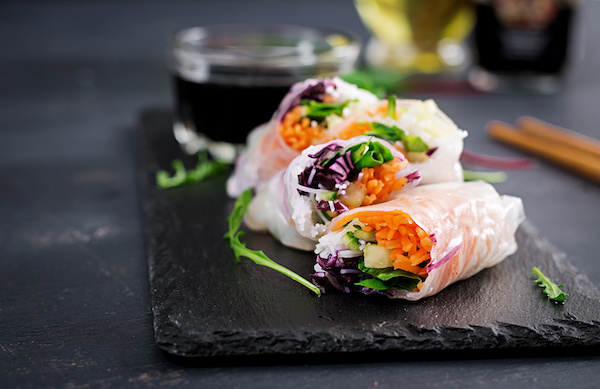Eating Out in a Thai Restaurant

This article originally appeared in the May 2003 McDougall Newsletter and has been updated in March 2023.
Thai restaurants are Mary’s favorite place to eat out of the house. She loves the curry flavors, the flavorful vegetables, and the “light feeling” about the whole meal. Curry is not John’s favorite, but he always knows a suggestion to eat Thai will make Mary happy. When we left Hawaii in 1987, one of Mary’s biggest regrets was no longer being able to eat at her favorite Thai restaurant, Mekong, in Honolulu. We are fortunate now to live in Northern California with an abundance of interesting ethnic restaurants. In our town in Sonoma County we have several Thai restaurants offering delicious “McDougall style” choices right on their menu.
Our favorite restaurant in Santa Rosa is called California Thai. They serve 26 “McDougall style” dishes on their menu (all of them very delicious) – and these dishes are very popular with vegetarians, as well as non-vegetarians. During our 10-day live-in program, one of the favorite “eating out experiences” is at this Thai restaurant. Before we go people tell us that they have been afraid to try Thai foods because of the spice. They are always pleasantly surprised to find that Thai food doesn’t have to be spicy to be delicious.
Thai menus always have a section of vegetarian selections; some are more extensive than others. Thai restaurants also cook food to order, and most dishes are not prepared ahead of time, so you can order your food the way you like. Don’t be afraid to insist on no animal products – and no added oil. Start by looking for vegetarian items, at least there is no meat, chicken, fish, or seafood here. Thai places do not use much dairy, except in Chai (a drink), which usually contains cow-milk. The other ingredient you have to pay attention to is the coconut milk. Coconut milk is high in saturated fat, and because this is fattening and raises cholesterol, you may want to avoid it. The second thing to focus your attention on is the vegetable oil used in almost all the cooking. Request your food be cooked with no oil (or “as little oil as possible,” – a phrase which often gets lost in the translation to the cook). Your server can check with the kitchen to find out which dishes are best to make oil-free.
Since your Thai dish is cooked to order, you have an opportunity to choose mild, medium or very spicy. The hot spice comes from chili added during cooking. I would suggest if you are new to Thai restaurants in general, or this is a new restaurant for you, order mild, or at most medium. You can always add spice from the chili jar found on your table.
Start with the appetizers section on the menu – look for fresh items, not deep-fried – like some type of Spring Rolls or Fresh Veggie Rolls. These are served cold and made with fresh vegetables, sprouts, herbs, sometimes tofu, and wrapped in a thin rice paper wrap. They are usually served with either a sweet and sour sauce or a peanut sauce. (Remember peanuts are high in fat so you might want to choose the lighter sauce.) On the appetizer menu you may find Lettuce Leaf Wraps. This dish is served as lettuce leaves upon which you pile an assortment of condiments, such as mint, peanuts, onions, chopped lime, coconut, and/or tofu, which all come in separate bowls. You roll the leaf up and top with a sweet and sour sauce. Grilled (not fried) Tofu Satay as a higher fat appetizer is often served with a peanut dipping sauce.
Move on to the soup and salad sections of the menu. You should find one or two vegetable soups, like Hot and Sour Vegetable Soup or Clear Vegetable Soup consisting of a clear vegetable broth (usually no-oil) and an assortment of vegetables. Most salads are healthy until they add the dressing. Ask for the dressing on the side or use a squeeze of lime juice and/or soy sauce on it instead – unless, of course, you remembered to bring your own bottled non-fat salad dressing from home. Som Tam is a Green Papaya Salad and one of our favorites – made from a raw green papaya, green beans and tomatoes with a lime dressing (no oil used) – spicing can be ordered mild to very hot.
When checking out the entrees, look for vegetarian options first, then go to the other sections of the menu and find some dishes made mostly of vegetables or rice noodles (these noodles are made from rice flour and water). If you find something that looks good and healthy, but contains beef, chicken, fish, or seafood, ask if they can make the dish without. Every restaurant has tofu available as a substitute for the animal products. Vegetarian Pad Thai, made from rice noodles, tofu, scallions, and bean sprouts, is one dish that most newcomers like and is served at all Thai restaurants around the world. To make it healthy, tell then to leave out the oils and animal products. Other noodle dishes can be ordered with any combination of basil leaves, onions, tomatoes, bell peppers, carrots, broccoli, mushrooms, bamboo shoots, bean sprouts, scallions, watercress, celery, garlic, and/or cabbage, and mixed with a Thai spicy sauce. Try Sautéed Eggplant with scallions, basil leaves and a bean sauce. Sweet and sour vegetable dishes, made with carrots, cauliflower; straw mushrooms and other assorted vegetables, and served over rice, are easy to find. Steamed white rice is a staple in Thai dining and always cooked without oil. It will be a rare treasure to find a Thai restaurant the serves whole grain “brown” rice – but it is always worth asking for.
Once you’ve found a great Thai restaurant that serves healthy dishes you will become a regular patron and probably try, like we do, to convince friends that the food is not too spicy and well worth a try.
Recommended Articles

Working with MDs

Vitamin D: Values for Normal Are Exaggerated





